A ‘Betwixtmas’ trip to the cinema, perhaps?
31 December 2020
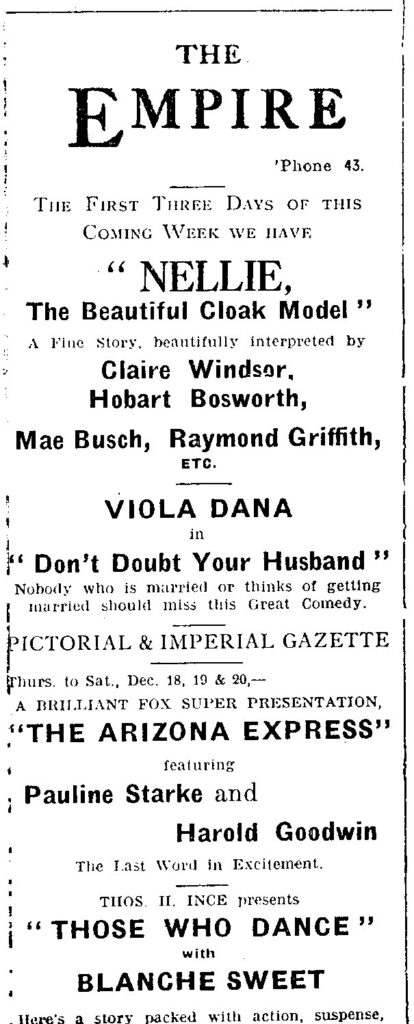
‘The cinema has always been a big attraction to the British public and nowhere more so than in Loughborough, where at different times we had one, two, three and four different cinemas operating. My first visit was with my mother in the early twenties. This was the new Victory Cinema, where I saw Charlie Chaplin and Jackie Coogan in The Kid. I shall never forget it.’
‘The next stupendous step for the entertainment of the people of Loughborough, was the talkies. The same cinema was the first to be wired for sound. For several weeks all the talkies we would see were shorts consisting of a phone conversation between two persons, someone singing a song or Olivier reciting from Henry V. But the main films were still silent.’
‘In about 1929 came the first full-length feature talkies to be shown in Loughborough. This was the Donovan Affair with Jack Holt, and almost all of the action took place in two rooms. Then came those great Hollywood musicals.’
‘The Victory was managed by Mr Higgins, who controlled the younger patrons with a rod of iron but was meekness personified when the well-to-do arrived in their best attire for the evening performances.’
‘The Empire did not have sound until sometime after the Victory, and I believe the first talkie was Rio Rita with Bebeh Daniels.’
‘The three cinemas belonged to a Mr Deeming who lived at One Ash, between Loughborough and Quorn. Every night one could see a member of staff taking the newsreels from one cinema to another, where they were shown at different times.’
‘Then came a competitor for the three. J Arthur Rank was to build an Odeon cinema on the site of the old GPO in Baxtergate. I worked on the construction of the Odeon from approximately January to October 1936. The first film to be shown at the Odeon was Mr Deeds Goes to Town, with Gary Cooper. One of the early films shown there was Rosemary, with Nelson Eddy and Jeanette MacDonald, and I went to see that film with my wife May for our first date.’
‘To combat the threat of competition from the Odeon, Mr Deeming and his fellow directors carried out huge investments. Firstly, the Empire was completely rebuilt and a brick-by-brick race appeared to be on to see which would open first. In fact, the main orders of both buildings were delivered almost to the day and severe disruption to traffic was caused along Nottingham Road, Baxtergate and the Marketplace. As far as the Victory was concerned, a large amount of money was spent on improvements for the comfort of the patrons, including the revolutionary idea of installing double seats on the back two rows of the balcony. My wife-to-be and I didn’t mind seeing a bad film under these new circumstances.’
‘Years ago the Empire boasted a beautiful ballroom where many of the large business firms held their annual functions. It was said to be one of the finest dance floors in the country.’
‘Another pleasant job we were asked to do occasionally was selling programmes at the Empire cinema celebrity concerts which were held on Sunday afternoons. At the commencement of the concert we were allowed to stay and listen. Some of the famous people who appeared were Cyril Smith the pianist, Anna Ziegler and Webster Booth, Yehudi Menuin and many more who gave their services free for charity.’
‘On the ground floor, in the foyer, there was a very popular coffee bar which was a favourite meeting place of students and other young people in the town.’
‘When the Empire Cinema was rebuilt there was a ballroom where you would have a meal and a dance. There were three cinemas – the Victory, the Empire and later the Odeon.’
‘On Saturday afternoons we went to the pictures – tuppence admission and a penny bag from a market sweet stall. If the cinema was full we will put two in a seat. We saw Hoot Gibson, cowboy films and thriller films as serials. ‘Come next week and see what the green Archer does!’ Mr Higgins was the manager of the Victory Cinema and you had to behave yourself.‘
‘On Saturday morning a strange hush came over the street as we all went to the Playhouse Cinema, ‘the flea pit,’ to see the latest instalment of Pearl White in ‘The Perils of Pauline’ or Elmo Lincoln in ‘Elmo the Mighty’ or some other earth-shattering drama. Later the Playhouse became the Palais de Danse and some of us patronised it for another purpose.’
Extracts from ‘Loughborough As I Remember It (Memories of the Town before 1945.)’ (Various contributors. edited by Jean Carswell, published by Leics Libraries, 1988)
Collated by Alison Mott
It was Christmas Day at the Workhouse …
30 December 2020
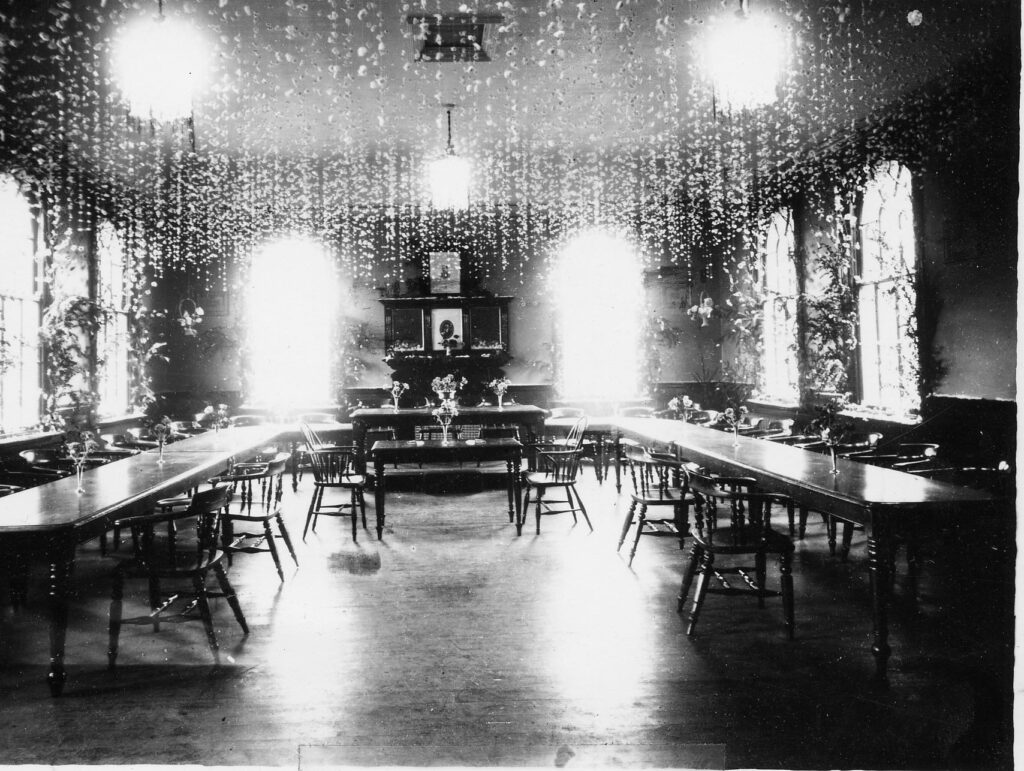
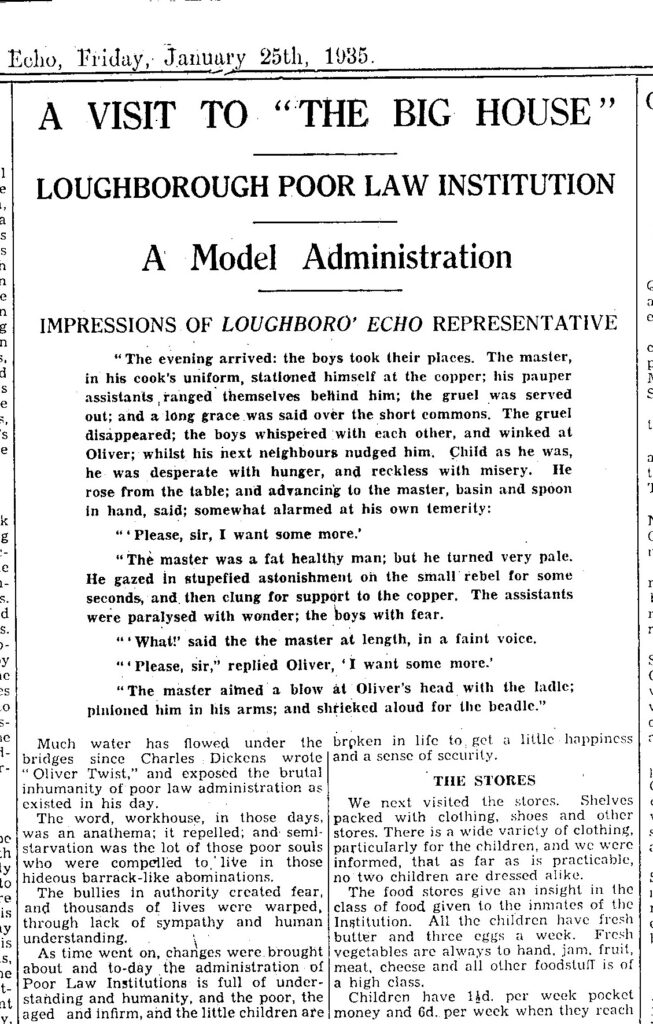
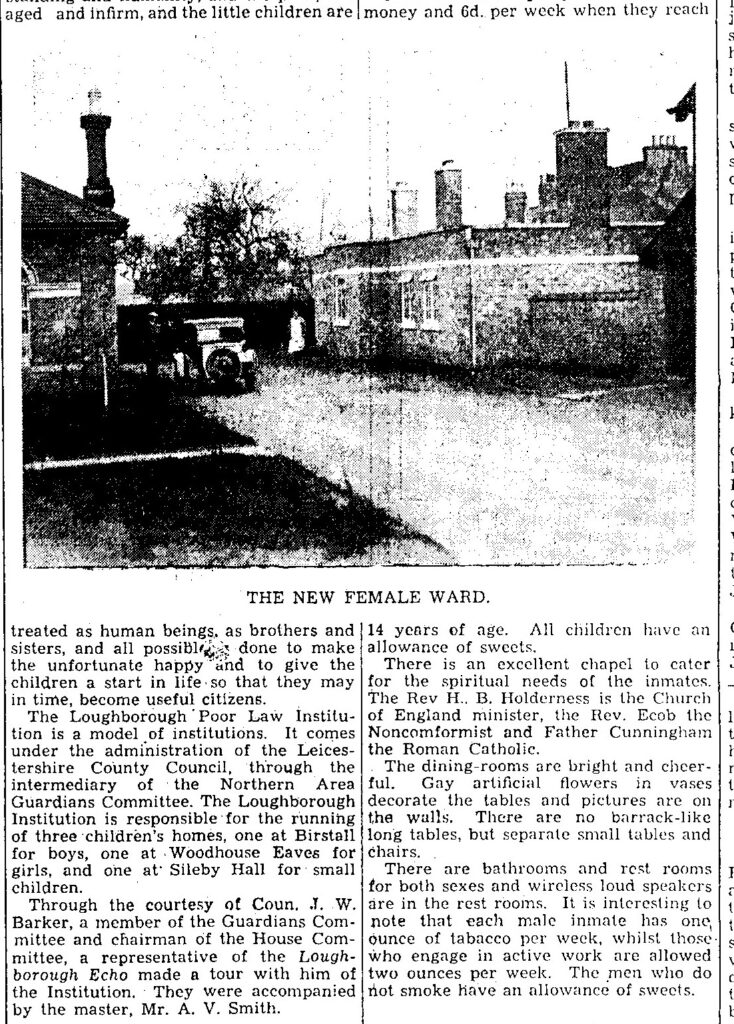
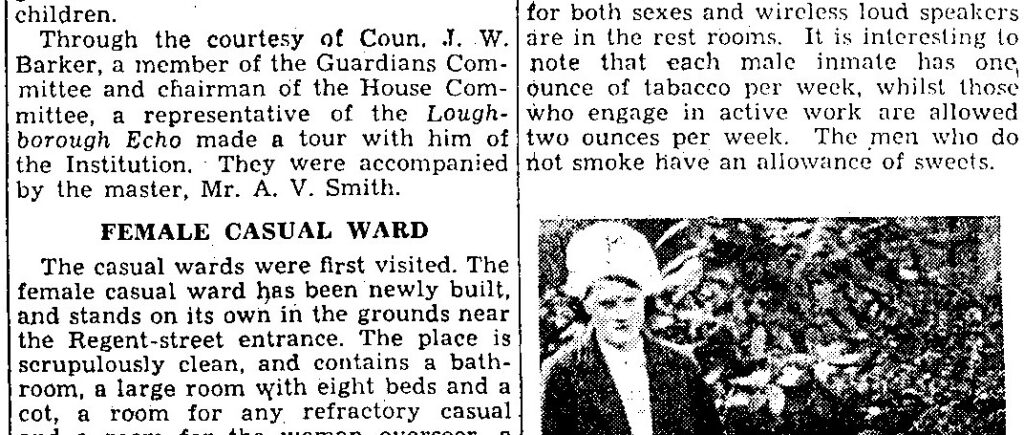
Read the poem ‘Christmas Day in the Workhouse’ by George R Sims here.
Read articles by Lynne Dyer about Loughborough’s workhouses here.
A cure for Christmas podge!
29 December 2020
On a snowy day in early December 2017, I nipped down to the Old Rectory Museum in Rectory Place to meet a friend of mine, Dr Sara Read of Loughborough University.
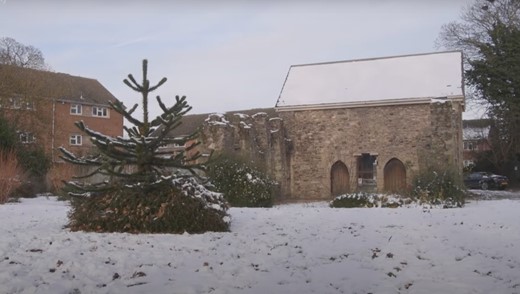
Sara is a specialist in early modern culture, literature, and medicine, (with a particular interest in women’s reproductive health) and had asked if she could use the Old Rectory as the backdrop for a short film. In it, Sara would recreate a 17th century recipe for surfeit water – an indigestion remedy for people who’ve eaten a surfeit – or excessive amount – of food. The film would be released over the Christmas period, a time when over-indulging in rich foods and drink is common.
I’m one of the volunteers with Loughborough Archaeological & Historical Society who run the Old Rectory Museum, and as we’re always looking for ways to raise public awareness of the building, Sara’s request was cheerfully granted. Hence me meeting her there, to let her in.
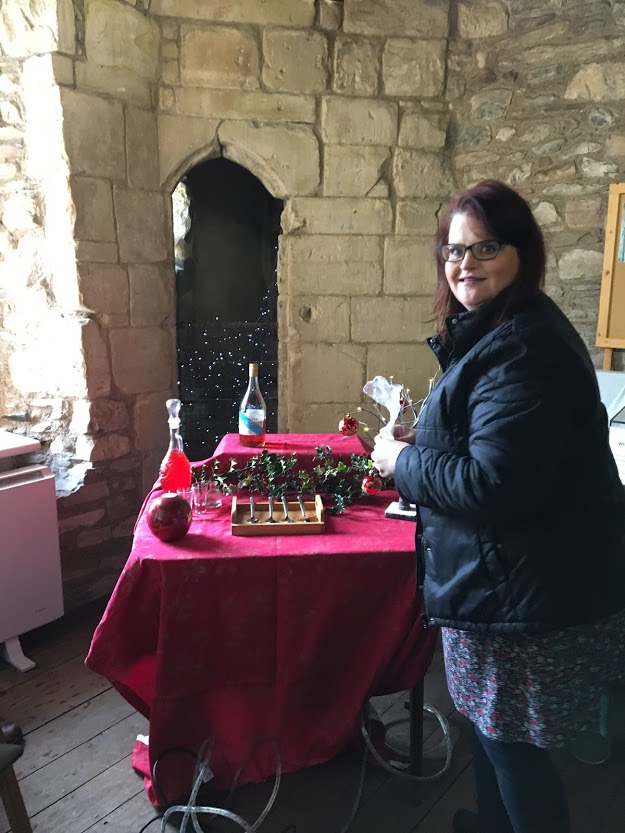
It was a very cold day indeed and at that point, the building’s heating system – installed when it was converted into a small museum in the early 1960s – wasn’t working. And despite being a short film, it took a couple of goes to record all the elements needed from different angles. I was lucky enough to be wearing a thick coat and gloves (though my poor feet were frozen!), but I watch the film back now in amazement at how well Sara coped with filming in just a thin dress.
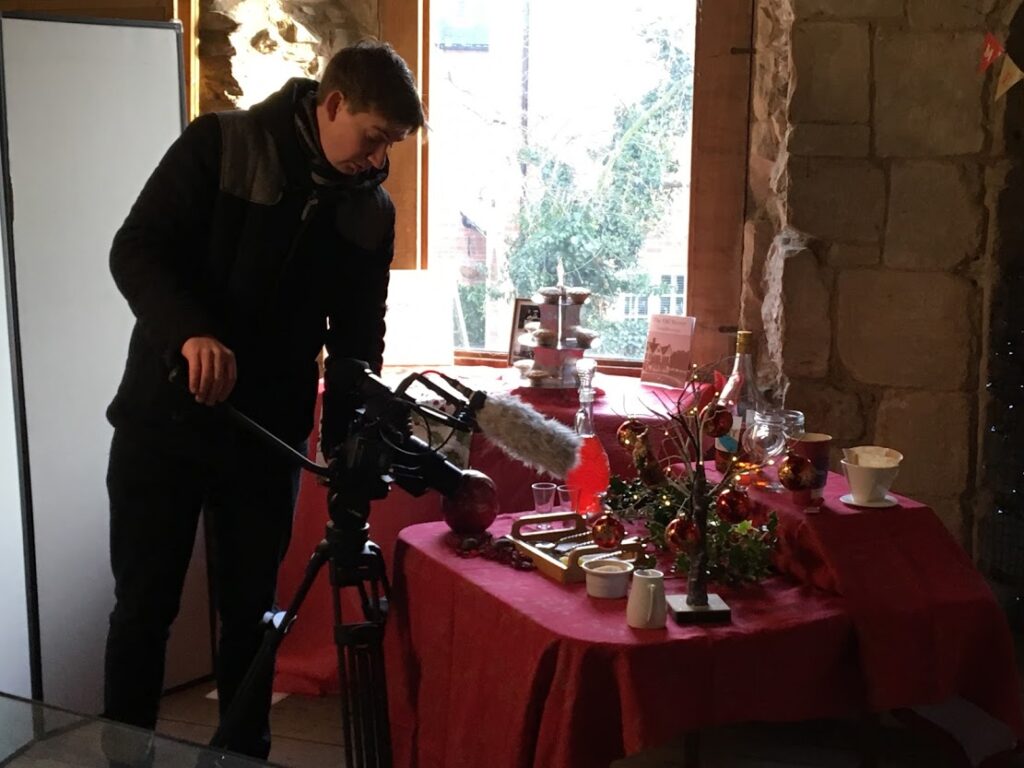
But it was great fun nevertheless. I loved seeing the upstairs solar blinged with Christmas decorations as a make-shift studio and watching Sara create a ‘medicine’ inhabitants of the Rectory might well have been familiar with back in the day.*
You can watch the film Sara and her team made here and access the recipe itself here.
Dr Read’s academic works on early medicine and 17th century women’s health can be found here.
Her first novel, ‘The Gossip’s Choice,’ about 17th century midwife Lucie Smith (Wild Pressed Books, 2020) can be found here.
Alison Mott
*The Rectory building is first noted in documentation in 1228 (though it will have been built some years prior to this) and is therefore some 500 years older than the written version of the recipe Dr Read used.
In the deep mid-winter …
28 December 2020
‘The winters seemed terrible. I can remember the canal freezing solid and the ice breaker would come down with seven or eight horses pulling it. In 1914 we had terrible snowstorms and the telegraph poles were lying flat on the railway. They were blown down in the blizzard.’
‘In the winter after a hard frost, we would go down to the Meadows to watch our elders skating on the ice and having a try ourselves at sliding. Some of the gang became quite adept at it but I always seemed to be facing the wrong way by the time I was halfway down the slide and finished either flat on my face or the other way round.’
Extracts from ‘Loughborough As I Remember It (Memories of the Town before 1945.)’ (Various contributors. edited by Jean Carswell, published by Leics Libraries, 1988)
Collated by Alison Mott
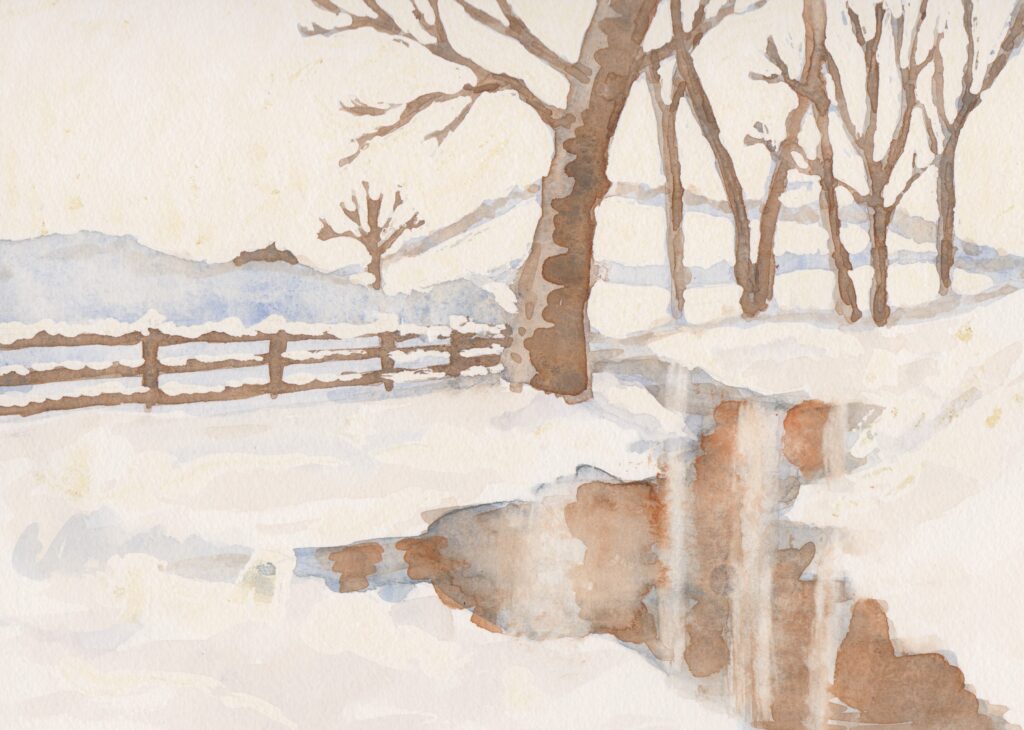
Loughborough Rugby Football Club – a history
27 December 2020
The Nineteenth Century
Loughborough Rugby Football Club (L.R.F.C.) was founded in about 1882 by C.D. Woolley, A. Thompson and William Webster. They played in a field in Moor Lane at the back of The Elms, the mansion and park of Mr. Henry Warner, hosiery manufacturer.
Mr. Woolley was a mainstay of the club until he met with a serious accident during a match and was forced to give up the game. They then had difficulty in fielding a full team of 15 players for away matches and the club closed.
It was revived in 1903 with Arthur Eddowes as its President and Mr. Ashe as Secretary and Captain. It was forced to close once more, to be reformed in its present form in 1929.
1929 and Onwards
Robin Wood and a group of enthusiasts re-formed Loughborough R.F.C. in 1929 with Mr. Wood as Secretary.
The club acquired a ground on Forest Road, thanks to the good offices of Mr. T.P. Towle, hosiery and knitwear manufacturer, who became the club’s first President, with Fred Mason as the first Chairman. The early enthusiasm of these players was sustained and they gained a reputation for playing good rugger.
Their ground moved to Park Road in Shelthorpe when the Forest Road site was scheduled for building construction. For one season they played at Browns Lane – the Mecca of soccer in Loughborough – but soon returned to Park Road where they stayed until the outbreak of WWII.
WWII (1939 to 1945) were lean years for the club, but the threads were picked up again in 1946. Unfortunately, the Park Road ground was not available but they managed to secure an agreement to play on Loughborough Cricket Club ground during the winter. With D.P.V. Laing as the first Chairman after WWII, the future plan was always to obtain their own ground and clubhouse.
At long last in 1948 when Loughborough Grammar School adopted the handling code[i], the town’s team had its nursery. The school, under the guidance of masters such as Harry Bowen, Bill Redden, Hayden Thomas and W.E. Williams, made rapid strides and was soon a force to be reckoned with in schools’ rugger. The school produced a steady stream of players who joined the town club when they left school.
Notable post-WWII names remembered are A.S. North (who became President of Leicestershire R.F.U. in later years), Cliff Hardisty, Owen Brown, J.A. Williams, Nigel Garton, Bill Colston, Roger Holt, Alan Toone, Don Wix, Stan Acons and -more recently – John Charles, Les Moseley, Terry Brewin and Alan Waters – all stalwart servants of the club.
Loughborough Rugby Club achieved their aim to have their own ground and clubhouse when they moved to their first home in Derby Road – complete with a wooden clubhouse which was officially opened in 1962. In 1982 a purpose brick-built clubhouse on the Derby Road playing fields was opened which became home, and still is, to the town teams. Due to the enthusiasm of the College and Junior College teams, the Grammar School teams, the Brush team and the L.R.F.C. town teams, over the years rugby in Loughborough has prospered and become a popular and integral part of Loughborough’s sports scene.
References:
Deakin, W. Arthur, The Story of Loughborough 1888-1914, Echo Press Ltd.
[i] The ‘code’ – or format – for Rugby Union. The team sports of rugby union and rugby league have a shared origin and bear many similarities.
Article by Loughborough Library Local Studies Volunteers.
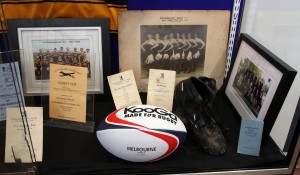
The Fox and the Hounds …
26 December 2020
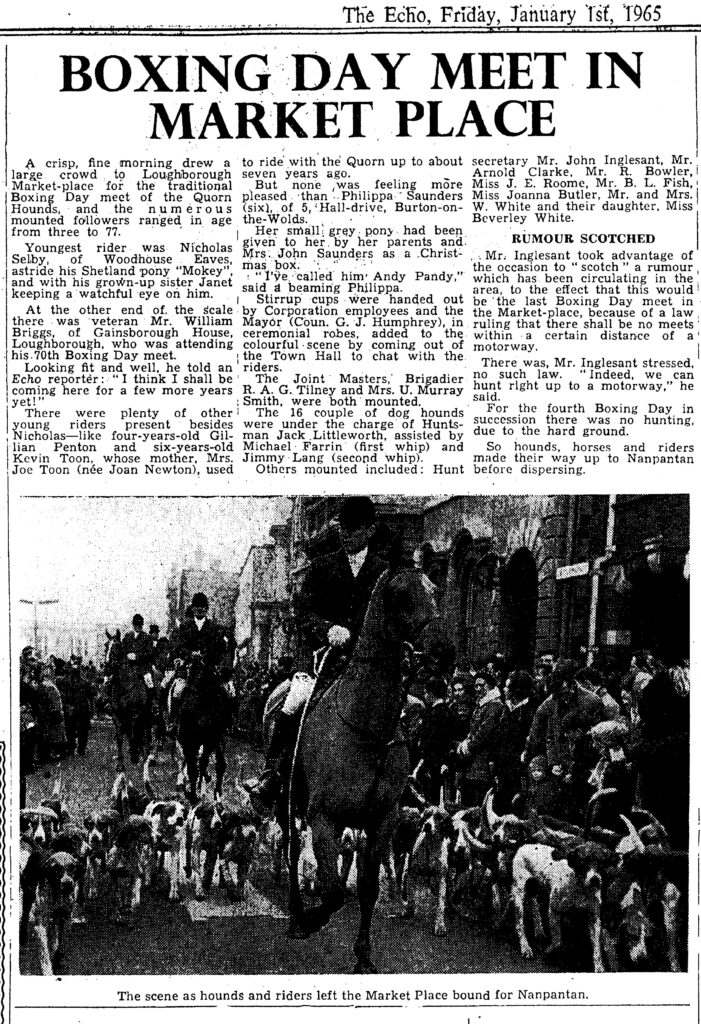
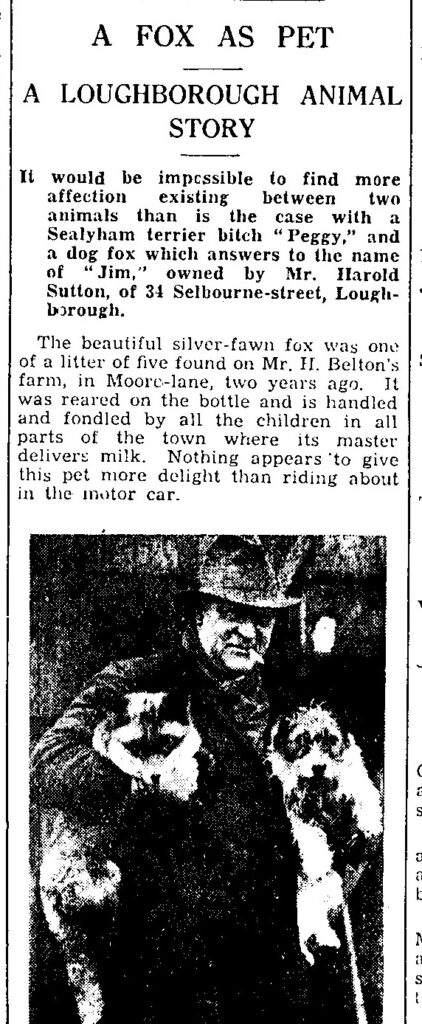
Merry Christmas everyone!
25 December 2020
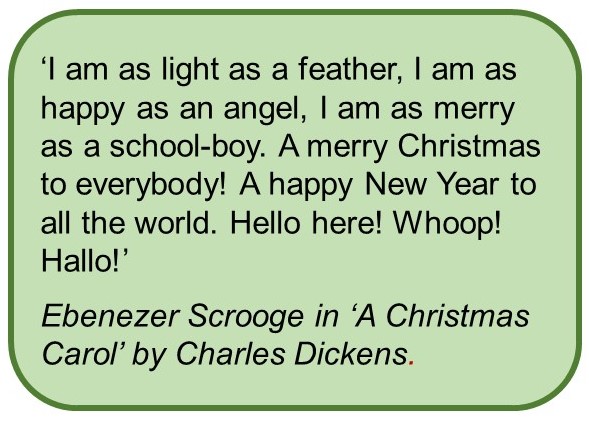

Wishing you all a happy, safe and hopeful Christmas. If history teaches us anything, it’s that all things – even bad times – will pass and happy days will return again.
Many thanks to everyone who’s sent me snippets of local history to post on the site since May, especially Loughborough Library Local Studies Volunteers. Particular thanks go to Sharon Gray, for her patience, encouragement and support, and to the members of my writing groups who have let me raid their bits of writing!
If you fancy a bit of nostalgia, read about Christmas Day in 1946 as remembered by Loughborough resident Jennie Harker or Christmas in my own childhood in the late 60s/early 70s.
Alison Mott, Loughborough History and Heritage Network
Christmas Eve in WW2
24 December 2020
During the Second World war we celebrated Christmas even though Britain’s future was uncertain. Despite food being rationed, many of us living in a village[1] had our own garden or allotments where our parents ‘dug for victory.’ We were able to produce fruit and vegetables and various herbs.
This state of affairs was taken as a culinary challenge. Neighbours did a lot of trading or swapping. Those who kept chickens were pleased to accept some vegetables in exchange for a dozen eggs. One neighbour received a food parcel from a relative in Canada and she gave us some sugar, a tin of salmon and some precious dried fruit.
We, as children, enjoyed making paper decorations – coloured chains that criss-crossed the front room, and small pieces of cotton wool threaded onto cotton and dangled down from the top of the window to look like snow. We also made paper lanterns to hang at intervals from the chains that stretched from the picture rail to the central ceiling light.
On Christmas Eve, my sister and I wrote letters to Santa Claus on small pieces of thin paper. I could write my name but needed Dad’s help with the rest of it. My sister did her best handwriting. We had been encouraged to ask Santa for a surprise rather than a specific (possibly unattainable) toy.
When the letters were finished, Dad would poke the fire a little, then he would send each small letter up the chimney, the smoke and heat lifting them up out of sight where, he said, the fairies would take them to Santa Claus. Then he would hang our stockings either side of the fireplace. Of course, we also had to leave a plate with mince pies and a glass of sherry for Santa on the mantlepiece. Mum would still be in the kitchen creating some warm, spicy cooking smells which followed us up to bed.
We shared a large bed, giggling and whispering to each other in our excitement. My sister told me that we must listen for the sleigh and the reindeer on the roof. When mum came up to tuck us in and kiss us goodnight, she said that we must go to sleep because Santa Claus only came when children were asleep!
J M Harker
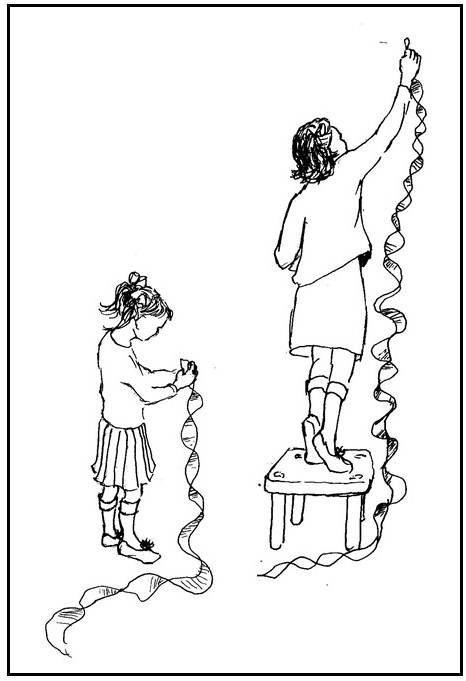
[1] Quorn
Charles Dickens visits Mount Saint Bernard’s Abbey
24 December 2020
In an article entitled ‘Out of the World,’ which appeared in ‘All the Year Round’ in 1859, Charles Dickens describes a visit to St. Bernard’s Monastery one Christmas Eve, nearly 90 years ago.*
Travelling by train from Euston he eventually arrived at ‘Buffborough,’ where he was met by an unnamed sombre individual who advised dining at ‘The Bull’s Head’ before setting off on the eight mile drive across country.
The meal, Dickens wrote, was utterly ordinary and unexciting. In the room above, convivial farmers were ‘keeping it up,’ clinking glasses, roaring out orders and ‘singing such long choruses as only heard in similar places.’
During dinner the author had been speculating as to what sort of vehicle would be provided to carry him to the Monastery. “I expected something quaint, odd, curious, a tumbril, perhaps driven by a novice, and drawn by a fat, lazy do-nothing horse.” He confesses his disappointment on finding a neat phaeton, hired from the inn, awaiting his pleasure.
He did begin to feel a little more romantic. “We turned out of the main road, and proceeded along what is little better than a bridle path, worn by long-continued rain, and intersected with deep ruts; high on either side rose green banks topped with a few scattered shrubs, bending mournfully in the wind blowing across the dreary landscape in fitful gusts.”
ST. JOSEPHS HOUSE
Darkness had fallen when the travellers reached ‘St. Joseph’s House,’ where guests of the Monastery were received when the Monastery itself was filled. “I caught a glimpse of a huge mass of rock surmounted by a tall cross when we finally drew up before a heavy Gothic building, in the large porch of which stood a Monk, a bona fide Monk, with close cropped hair, long white flannel robe and cowl, dark scapulary (as spelt) and all monastic appurtenances fitting.”
The distinguished visitor was apparently very well pleased with the warm reception accorded him and comments appreciatively on the accommodation and amenities provided for his use.
At first the dead silence oppressed him, “but it must be favourable to meditation, I suppose, for a few minutes I found myself seated on the bed and deep in reveries. Last night, I was at the theatre, joining in a laughing chorus some two thousand strong. Where am I now? In a cold grey building, situated in the midst of the wildest forest scenery, and inhabited by a few men who exist indeed, but scarcely be said to live.”
Dickens was evidently not much impressed by the asceticism of the St. Bernard community, and one feels an undercurrent of disapproval running through much of his description. Nevertheless, he took a liking to at least one of his hosts, Father Lawrence, the Guest Master, of whom he says, “I have never seen a sweeter expression of face, slightly worn, slightly ascetic, but when he smiles his grey eyes light up, his white teeth gleam, and he is the embodiment of good humour.”
THE REFORMATORY
It was Father Lawrence who took him to see the nearby reformatory for Roman Catholic boys, some 200 of them, all criminally convicted, who broke off their games when he arrived to flock round his companion, for whom they showed the greatest affection.
The visit coincided with a ceremony, conducted by the Abbot, in consecration of the new image of the Virgin Mary presented by friends of Father Lawrence to the Boys’ Chapel.
THE MONK WHO DIED
It was immediately after the service that Dickens’ new acquaintance collapsed in the middle of a conversation. Dickens caught him as he fell, and was shocked and horrified to see him die. Small wonder, then, that the remainder of his visit passed as a bad dream. He says, “…. but one recollection is boldly prominent and that is my astonishment at the apathy of the dead man’s comrades …. a young man, apparently in full health, is struck down, and with less than five minutes warning is numbered with the dead, and scarcely the least sign of sorrow, or even surprise, is exhibited by those among whom several years of his life have been passed.”
Description of ritual, service and ceremony follows, but behind and through it all Dickens sees the dead man’s face. He cannot shut it out. When, on taking his leave he is asked to visit the Monastery at some more favourable season he says, “Perhaps I may, for though I was enabled to see but little of the ordinary lives and habits of those monks, never were the events of any twelve hours so firmly impressed on my mind as those which I spent ‘Out of the World.’
By T. D. Pearce, 1st February 1943
*Extract from an article which appeared in ‘The Loughborough Echo, on December 26th, 1947, written by Mr. T. D. Pearce, the Borough Librarian, from a collection of news cuttings made by the late Rev. W. G. Dimlock Fletcher which were held at Loughborough Public Library.
This item was sent to us for posting by Loughborough Library Local Studies Volunteers, with special thanks to Gerald Berrington.
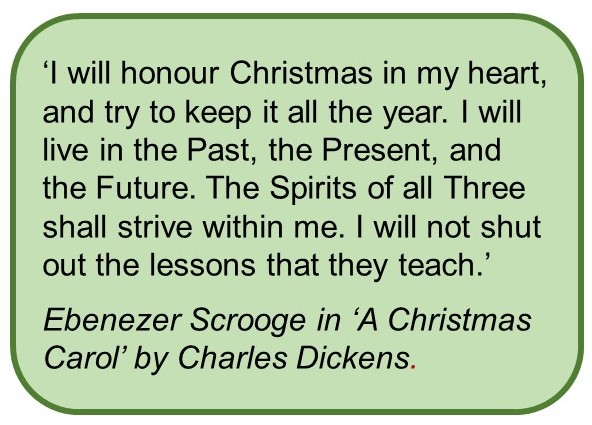
‘We always read ‘A Christmas Carol’ at Christmas time – it’s often on the television, too. He likes old Dickens don’t you? Every Christmas for as long as I can remember. We read it aloud so we can read it together.’
Memories of Christmas as shared by a resident of a local care home for the elderly and her husband in December 2019.
Listen to a re-telling of ‘A Christmas Carol’ here.
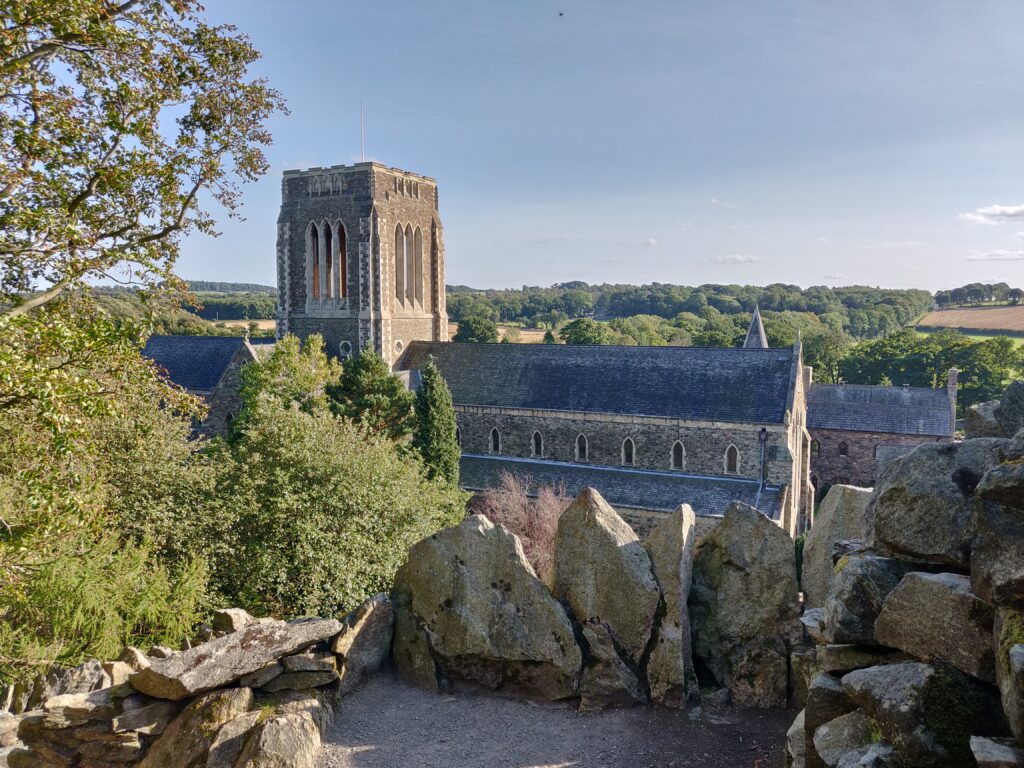
On this day in Loughborough … 1869
23 December 2020
23rd December 1869
James Shaw, Town Hall Yard Photographic Rooms, still continues to execute Carte-de-Visite Portraits in the best style at 5/0 d per dozen.
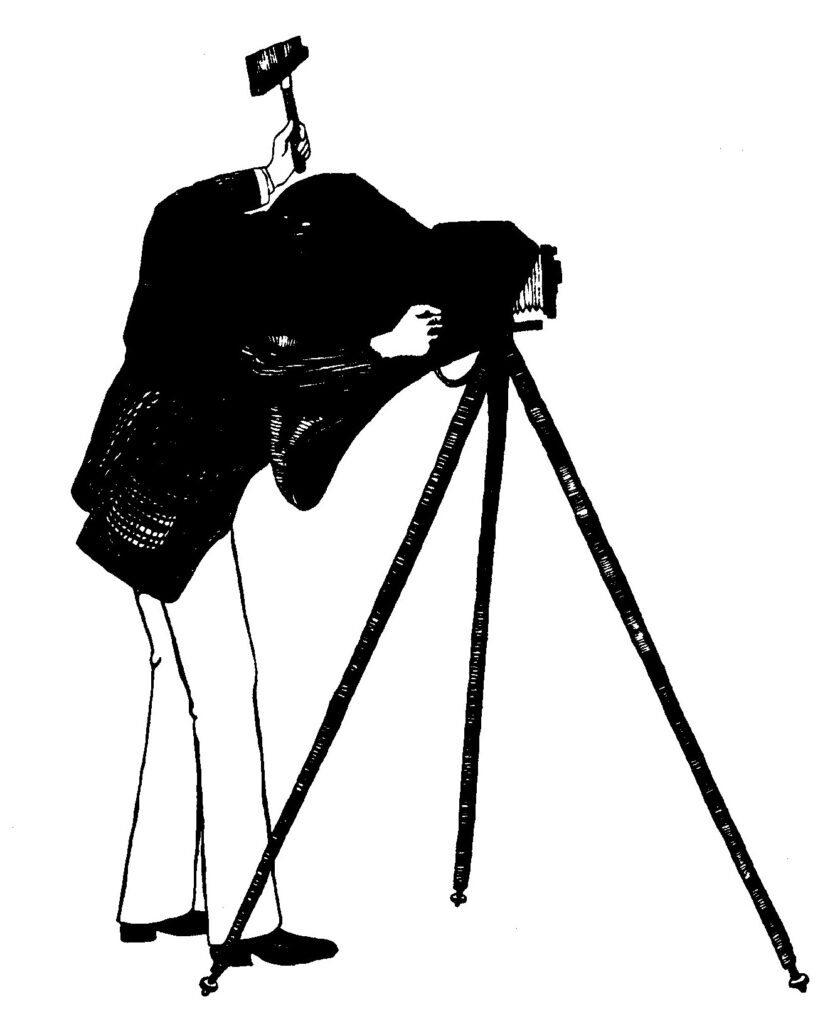
Snippets of history from the Loughborough Advertiser, Loughborough Herald and Loughborough Monitor, collated by Loughborough Library Local Studies Volunteers. Source: Matthew’s Local Newspaper Extracts Vol. 1